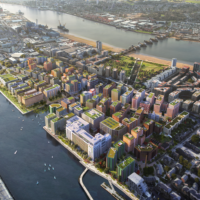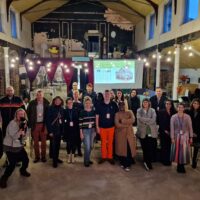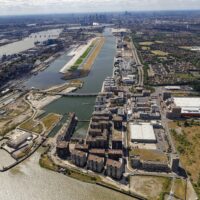
Regeneration news
From Sweden to Seoul: Global delegations visit Royal Docks for insights on regeneration and placemaking
In recent weeks, the Royal Docks has become a hub of international exchange, welcoming high-profile delegations from Helsinki, Gothenburg, and Seoul. Each delegation was keen to explore particular aspects of the ambitious Royal Docks regeneration programme and our collaborative approach to placemaking.
Helsinki delegation explores partnership strategies for large-scale regeneration projects
During a multi-day visit to London, senior politicians from Helsinki, including Mayor Juhana Vartiainen and deputy mayors for planning, visited the Royal Docks to gain insights into the scale and opportunity of the area’s transformation.
Hosted by Lendlease at the flagship Silvertown site, the Royal Docks team, alongside Ed Mayes, Project Director for Silvertown, and representatives from the Greater London Authority’s Regeneration team, presented the strategic vision for the area, highlighting the creation of 6,500 new homes, the restoration of Millennium Mills, and plans for community spaces and next-generation workspaces.
The Helsinki delegation was particularly interested in how local and central governments collaborate with developers to deliver large-scale regeneration projects, supported by new infrastructure such as the planned Silvertown bridge across Royal Victoria Dock. They were equally keen to learn how the Royal Docks balances historic preservation and heritage with new developments that meet contemporary needs.
The visitors had the opportunity to take in panoramic views of the Royal Docks’ key heritage sites, including Millennium Mills and Silo D, from the rooftop of the Silvertown site office, offering a unique perspective on the area's past and its future transformation.


Swedish delegation gains insights into co-creation for inclusive urban design
Meanwhile, a delegation of urban planners, project managers, and landscape architects from Gothenburg City Council visited to explore how the Royal Docks Team is incorporating inclusive design into the creation of new public spaces, drawing comparisons with their own redevelopment of Frihamnen - a project revitalizing historic shipyard land in Gothenburg.
Much like the Royal Docks, Frihamnen is a large-scale regeneration programme transforming a post-industrial landscape into a vibrant, mixed-use neighbourhood, balancing maritime heritage with new housing, infrastructure, and green spaces. Both programmes share a vision of co-creating spaces that bring together diverse communities and foster inclusion.
The Swedish delegation toured key sites, beginning with Thames Barrier Park, where the Royal Docks’ Head of Development & Placemaking, Paul Creed, introduced the importance of early public space interventions in facilitating housing developments.
The Gothenburg team showed particular interest in how community involvement informs the development of public spaces. Rawnak Jassm, Community Engagement Manager, shared insights into discussed how community input influenced upgrades to Thames Barrier Park and shared examples of People Powered Places projects such as ‘Painting in the Park’, which illustrate how public spaces foster community connection and engagement. The delegation also toured Royal Wharf and the Royal Docks Corridor, learning how communities input to the collaborative planning efforts aimed at improving safety with enhanced crossings, rain gardens, and upgraded pedestrian and cycling routes.


South Korean delegation explores sustainable urban waterfront designs at Thames Barrier Park
In a further demonstration of international interest in the Royal Docks, the team welcomed a delegation from Seoul Metropolitan Management Corporation, responsible for the city’s landscaping and public realm. With a particular interest in sustainable and environmentally-friendly design for waterfront spaces, the delegation visited Thames Barrier Park for a guided tour led by the park’s visionary architect, Andrew Taylor, Director of Patel Taylor architects.
Designed in the 1990s by Patel Taylor in collaboration with Allain Provost, Alain Cousseran, and Arup, this 14-hectare post-modern masterpiece has not only stood the test of time but continues to be one of London’s most exciting landscapes. It is a rare demonstration of how thoughtful landscape design can shape and transform the city around it.
The delegation learnt how the area was transformed from a derelict brownfield site into a vibrant 14-hectare green space, including its 40-metre sunken ‘Green Dock’ providing a sheltered microclimate for plants and wildlife, recognised with multiple awards, including seven consecutive Green Flag Awards.
The Seoul delegation was particularly interested in how Thames Barrier Park served as a catalyst for the regeneration of the surrounding area, playing a pivotal role in sparking the development of new housing, schools, and amenities and showcasing how thoughtful landscape design can shape and enrich urban spaces for the long term.
Across all three visits, the Royal Docks team shared valuable insights on regeneration, placemaking, community engagement, and sustainable urban development. From Helsinki’s large-scale city renewal projects to Gothenburg’s focus on inclusive public spaces and Seoul’s interest in eco-friendly waterfront design, these exchanges highlight the Royal Docks as a key global hub for knowledge sharing, fostering dialogue on how cities can develop vibrant, sustainable, and inclusive spaces for their communities.


